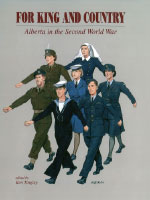Morale and Morality on the Alberta Homefront
Jeff Keshen
Reprinted with permission of the author and publisher of For King and Country: Alberta in the Second World War The wartime focus upon truancy and delinquency also appears to have rekindled an early twentieth-century campaign inspired by the Progressives, which faded by the 1920s, that called for a comprehensive and compassionate system of dealing with juvenile offenders. In 1908 Ottawa had passed a Juvenile Delinquents Act setting down guidelines for municipalities to establish separate youth courts. By 1914, Winnipeg, Halifax, Charlottetown, Montreal, Ottawa, Toronto, Vancouver, and Victoria had responded, and three years later, Alberta came on board, technically applying the legislation throughout the province.66 Still, at the outset of the Second World War, only Canada's largest urban centres had juvenile courts, according to a 1943 Alberta report, thus frequently leaving youth to be tried as adults. It also noted that judges were often regular magistrates with no special training to deal with children; psychologists were, at best, used sparingly; parole officers were few in number and poorly trained; and inadequate detention facilities for youth often existed, such as in Edmonton where boys stayed in an adjunct of the local adult jail.
The wartime focus upon truancy and delinquency also appears to have rekindled an early twentieth-century campaign inspired by the Progressives, which faded by the 1920s, that called for a comprehensive and compassionate system of dealing with juvenile offenders. In 1908 Ottawa had passed a Juvenile Delinquents Act setting down guidelines for municipalities to establish separate youth courts. By 1914, Winnipeg, Halifax, Charlottetown, Montreal, Ottawa, Toronto, Vancouver, and Victoria had responded, and three years later, Alberta came on board, technically applying the legislation throughout the province.66 Still, at the outset of the Second World War, only Canada's largest urban centres had juvenile courts, according to a 1943 Alberta report, thus frequently leaving youth to be tried as adults. It also noted that judges were often regular magistrates with no special training to deal with children; psychologists were, at best, used sparingly; parole officers were few in number and poorly trained; and inadequate detention facilities for youth often existed, such as in Edmonton where boys stayed in an adjunct of the local adult jail.
Recognizing the present system as inadequate to deal with wartime delinquency, and fearful of yet higher levels during the early postwar period which many feared would be plagued with high unemployment, Alberta established a committee that year to examine juvenile crime. After hearing from 35 people or groups working in the area, its formal recommendations included: an increase in the number of courts; the appointment of judges clearly familiar with current psychological theories about deviant youth; the creation of special observation facilities where before a trail a child might be examined by a psychologist; the establishment of more detention facilities keeping youth separate from adults and placing rehabilitation over punitive measures; and better training, perhaps at universities, for parole officers, as well as their appointment on the basis of one per 5000 people.67
Change did not occur overnight, but by the time the war ended some improvement was evident. Part-time psychologists were assigned to courts in Edmonton and Calgary; pre-trial observation centres were created in both jurisdictions; the provincial government publicly committed itself to improving the calibre of its judicial and parole services; and in 1945 Edmonton and the Alberta government both contributed a total of $40,000 for a new South Side detention centre. At this centre the plan was to segregate boys according to age and the seriousness of their crime, assign them to a house leader to approximate a family environment, and in addition to academic lessons, to provide them with training in either industrial arts or farming.68
The Second World War brought much excitement and opportunity, as well as commotion and anxiety, to the Alberta home front. In addition to countless citizens whose actions reflected their patriotism, there were those who bemoaned the turmoil which came to their once-tranquil setting; in addition to those businesses which legitimately prospered by serving a new military clientele were those individuals who grew rich on the black market; accompanying the thrill of meeting soldiers from around the world were concerns about growing moral laxity; and counterbalancing the new roles and ambitions of some women was apprehension over family stability which played a fundamental role in producing a postwar conservative backlash.
Although evident throughout Canada, such conditions were perhaps more profoundly felt in places like Alberta where practically overnight communities were thrust into a pace of life and confronted with social problems on a scale usually associated with big cities. What these exciting and unsettling experiences also suggest is that the Second World War proved to be a national experience for Alberta, beyond its common resolve with the rest of Canada to defeat the Axis powers, perhaps due to the fact that its residents met so many people from different parts of the country. In being opened up to a wider world so quickly and on such a grand scale, and then in taking a number of initiatives both to employ the potential and contain the negative manifestations of what rapidly became an increasingly complex socio-economic environment, Alberta demonstrated its growing sense of identification in common with a generally modernizing nation.
Notes
66. Neil Sutherland, Children in English-Canadian Society: Framing the Twentieth Century Consensus, [Toronto: University of Toronto Press, 1976], pp. 125-6.
67. PAA, Accession Number 70.414/2147, Records of Department of Social Services, report of the Child Welfare Committee as Appointed by Orders in Council Nos. 913/43 and 1256/43.
68. CE, RG 11, Class 32, File 9, Mayor Fry to City Council, 12 March 1945.








